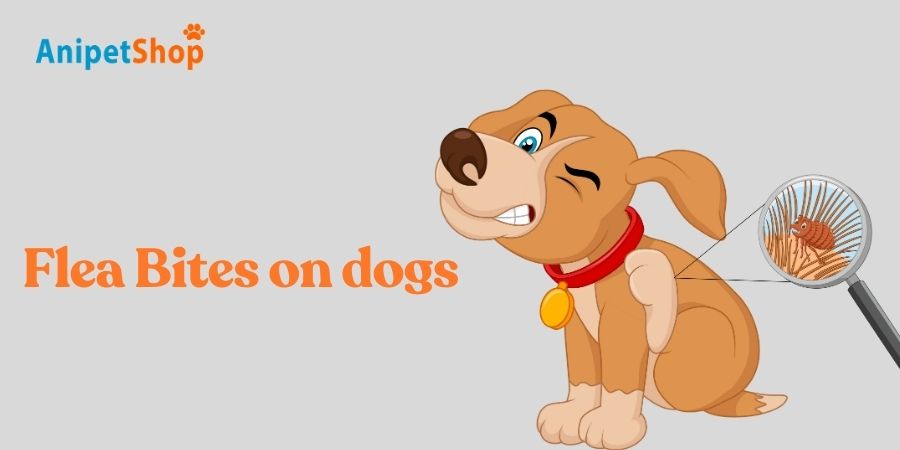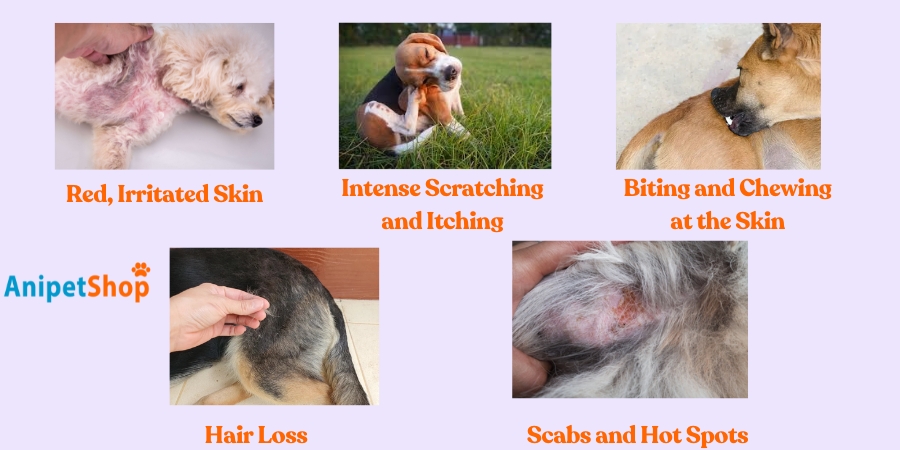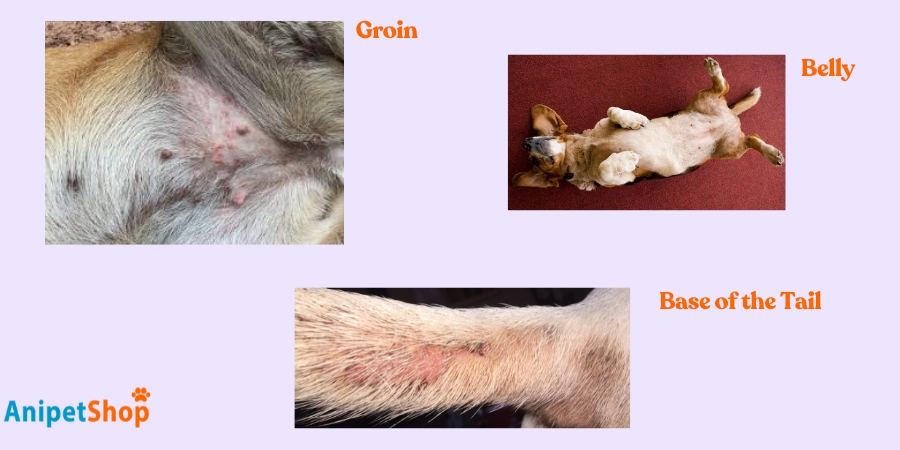Flea Bites on Dogs: What Are They Like and How to Treat Them?
Flea bites on dogs appear as small, red, raised bumps that can cause intense itchiness and discomfort. These bites are most commonly found around the groin, belly, and tail base. Dogs may experience hair loss, swelling, and scabs due to relentless scratching and licking. Left untreated, flea bites can lead to secondary skin infections, Flea Allergy Dermatitis, and even anemia. Treatment involves using flea control products, bathing your dog with medicated shampoo, and cleaning your home environment thoroughly. For more about ensuring your dog’s comfort and health, continue below.
Key Takeaways
- Flea bites are extremely itchy.
- A red, swollen weal develops within 30 minutes of the bite.
- The weal may turn into a blister or small wound after a day.
- Legs and feet are often targeted.
- Secondary infections from scratching are common.
- Some people may become very sensitive to bites.

What do flea bites look like?
Flea bites appear as small, red, raised spots on a dog’s skin. They’re generally smaller than other insect bites but can become inflamed if a dog scratches excessively. Some dogs have a heightened sensitivity to flea saliva, which can cause a larger, more intense red area around the bite.
Flea bites can cause a range of uncomfortable symptoms for dogs, often leading to skin irritation and more severe issues if left untreated. Here are some common signs of flea bites to look for:
- Red, Irritated Skin: Flea bites leave small, red, raised spots on the skin, which can become inflamed due to constant scratching. Areas with thinner fur, such as the belly or inner thighs, may show these bites more clearly.
- Intense Scratching and Itching: Flea bites are intensely itchy, and dogs will often scratch or rub themselves persistently to try to relieve the discomfort. The itching can quickly worsen if the flea saliva triggers an allergic reaction.
- Biting and Chewing at the Skin: Dogs may also chew or nibble at areas where fleas have bitten, especially around the base of the tail, hindquarters, and abdomen, where fleas tend to gather. This constant biting can lead to further irritation and open sores.
- Hair Loss: Continuous scratching and biting often result in patches of hair loss, particularly in flea-prone areas. In severe cases, these bald spots can expand, exposing more of the skin to possible infection.
- Scabs and Hot Spots: Flea bites can cause scabbing and the development of “hot spots” — areas of red, inflamed, and sometimes oozing skin that are painful to the touch. These sores increase the risk of bacterial infection if left untreated.
Flea bites typically cause mild irritation and discomfort that resolves on its own, but they can sometimes lead to more serious health risks. While bites rarely cause lasting harm, fleas can spread diseases that are potentially severe or even fatal. If you notice symptoms such as intense itching, red or irritated skin, or excessive biting and scratching, it’s important to check your dog for fleas. These signs often indicate an infestation, which requires prompt attention to keep your dog safe, healthy, and comfortable.

Where are Flea Bites Found on Dogs?
Although fleas can live anywhere on your dog, their bites are typically concentrated in specific areas. When examining your dog for flea bites, focus on common hotspots such as the belly, groin, and base of the tail. These areas often show red, bumpy rashes from flea bites, making them easy to identify and more prone to irritation. Checking these spots closely can help you quickly detect fleas and begin treatment, providing relief for your dog.
- Groin: The groin is one of the first places to check for flea bites. This area is often targeted because the fur here is typically sparse, making it easy for fleas to access the skin. Flea bites in this area are usually easy to spot, often appearing as red, raised bumps on the exposed skin.
- Belly: Like the groin, the belly has relatively little fur, which allows fleas to bite and feed with less interference. Flea bites on the belly usually appear as a red, rash-like pattern. Because this area is exposed, checking for bites on the belly is a quick way to spot an infestation.
- Base of the Tail: The base of the tail is another “hot spot” for flea activity. Fleas tend to gather here because it’s a harder area for dogs to reach, allowing them to feed with minimal disruption. To find bites in this area, use a flea comb to part the fur and check for red, irritated spots or flea dirt (flea droppings) near the skin.
By regularly checking these common areas for signs of flea bites, you can catch infestations early and prevent further irritation for your dog.

Flea Bite Complications
Flea bites are more than just irritating; they can lead to serious health issues for dogs, making flea control and prevention essential. The three primary concerns related to flea infestations are:
- Flea Allergy Dermatitis (FAD): Flea allergy dermatitis is the most common skin disease affecting dogs in the United States. FAD occurs when a dog has an allergic reaction to flea saliva, resulting in intense itchiness, red and inflamed skin, hair loss, scaly patches, and secondary skin infections due to persistent scratching and biting. Even a single flea bite can trigger an allergic response in some dogs, causing severe discomfort and making the skin vulnerable to infections.
- Anemia: Fleas have enormous appetites relative to their size, capable of consuming up to 15 times their own body weight in blood each day. To put this into perspective, that’s equivalent to a 100-pound human eating 1,500 pounds of food in just 24 hours! This continuous blood loss can lead to anemia in heavily infested dogs, particularly in puppies, elderly dogs, or those with compromised immune systems. Signs of flea-induced anemia include pale gums, lethargy, weakness, and in extreme cases, collapse. If a dog shows signs of anemia, prompt veterinary care is crucial, especially for younger or more vulnerable pets.
- Tapeworm Infection: Dogs often ingest fleas while scratching or grooming, and fleas can carry tapeworm eggs. When a dog swallows an infected flea, the tapeworm eggs are released and hatch in the dog’s intestines, where they develop into adult tapeworms. Although tapeworm infections are generally not severe, they can cause discomfort, weight loss, and digestive issues. Fortunately, tapeworms are treatable with medication, but preventing fleas in the first place helps reduce the risk of reinfection.
Flea bites can therefore lead to significant health problems beyond mild irritation. Addressing a flea infestation quickly and maintaining regular flea prevention treatments help protect dogs from these serious complications, keeping them comfortable, healthy, and safe.
Treatment for Flea Bites on Dogs
Flea bites usually do not require treatment but relieving itching and preventing infection is important. Over-the-counter anti-itch creams, ointments, and antihistamines can help alleviate itchy skin and discomfort. If severe symptoms like allergic reactions, fever, headache, or body aches develop, consult your healthcare provider.
Here are some effective ways to treat flea bites:
- Avoid scratching the bites to prevent further irritation.
- Clean the affected area with antiseptic soap to minimize infection risk.
- Apply an ice pack regularly to reduce swelling.
- Use calamine lotion or anesthetic creams to alleviate itching.
- Bathing your dog with gentle flea shampoo helps remove fleas and soothe irritated skin.
- Consult your pharmacist about antihistamine medications to help manage swelling.
- Consider treatment for potential tapeworm infections, as fleas can transmit this parasite.
- See your doctor if symptoms worsen or if you notice signs of a secondary infection, such as pus.
For severe allergic reactions or flea allergy dermatitis (FAD), oral medications like antihistamines or corticosteroids may be necessary. These reduce systemic inflammation and severe itching. Always follow the veterinarian’s dosage instructions to avoid side effects.
Eliminating the root cause is crucial. Use oral or topical flea preventatives containing insecticides like fipronil or imidacloprid to kill adult fleas and prevent new infestations. Additionally, maintain a clean environment by vacuuming living areas and laundering bedding and soft furnishings.
In severe cases, professional pest control services might be needed to eradicate a home infestation. By combining these methods, you can relieve your dog’s discomfort and create a flea-free environment. Consult your vet to develop the most effective flea removal plan for both your dog and home. Fleas can take some time to completely eradicate, so it’s best to act quickly. Meanwhile, try to keep your dog off furniture and avoid letting them sleep in your bed. Additionally, explore reliable methods for eliminating fleas to ensure your household remains flea-free.
Read more: How to treat fleas on dogs?
How to Prevent Flea Bites on Dogs?
Preventing flea bites on dogs is essential for keeping them healthy and comfortable year-round. Once you’ve cleared your dog of any fleas, maintaining an effective flea prevention routine is key to avoiding future infestations. Since most dogs regularly go outdoors, using a comprehensive flea prevention approach that includes protection against other pests—such as ticks, heartworm, and intestinal parasites—provides extra security.
Here are some popular flea prevention methods to consider:
- Oral Preventatives: These medications are taken by mouth and circulate through your dog’s bloodstream, effectively killing fleas when they bite. Oral preventatives often offer extended protection and are convenient for dogs that don’t tolerate topical treatments well.
- Topical Preventatives: Applied directly to your dog’s skin, typically between the shoulder blades, these treatments spread across the skin’s natural oils, offering protection against fleas, ticks, and sometimes other pests. Topicals are easy to apply and are effective for dogs who go outdoors frequently.
- Flea Collars: Flea collars are worn around the neck and provide long-lasting flea prevention by releasing active ingredients that repel or kill fleas. When using flea collars, ensure they fit snugly without being too tight, and look for collars with a breakaway feature for safety. Trim any excess length to prevent your dog from chewing on it, as ingesting chemicals can be harmful.
A combination of these methods is often recommended for comprehensive protection. For personalized product suggestions, check out guides on the best flea treatments for dogs to help you find options that suit your dog’s needs and lifestyle. With consistent prevention measures, you can reduce the risk of flea bites and keep your dog comfortable and pest-free.
Are flea bites on humans dangerous?
Flea bites are typically easy to spot on humans, as they appear as small, red, raised dots that may itch intensely. Shortly after a flea bite, a small, discolored bump often forms, sometimes surrounded by a faint ring or halo. Flea bites tend to occur in straight lines or clusters and are most commonly found on the lower legs, such as the feet, calves, and ankles. Flea bites above the knee are less common unless you spend extended periods sitting or lying down. While the appearance of the bites is noticeable, the itching and irritation they cause are usually the most bothersome symptoms.
Most flea bites are irritating but not harmful. Fleas can bite humans, leading to itching and discomfort, with bites typically lasting a few days. Some people might not notice they’ve been bitten, while others feel very itchy, depending on their skin sensitivity and the severity of the flea infestation. Anti-itch creams, ointments, and antihistamines can help ease the itchiness.
Flea bites are typically easy to spot on humans, as they appear as small, red, raised dots that may itch intensely. Shortly after a flea bite, a small, discolored bump often forms, sometimes surrounded by a faint ring or halo. Flea bites tend to occur in straight lines or clusters and are most commonly found on the lower legs, such as the feet, calves, and ankles. Flea bites above the knee are less common unless you spend extended periods sitting or lying down. While the appearance of the bites is noticeable, the itching and irritation they cause are usually the most bothersome symptoms.
The red or discolored marks usually fade within a week. However, if you have sensitive skin or other conditions, they may take longer to disappear. Call your doctor if you experience severe symptoms, including fever, headache, or body aches.
Flea bites on dogs present as small, red, itchy bumps, often leading to symptoms such as intense scratching, hair loss, and skin infections. Complications may include allergic reactions and secondary infections. Effective treatment involves topical or oral medications, proper hygiene, and environmental control measures.
Preventative strategies include regular use of flea preventatives and maintaining a clean living space. Addressing flea bites promptly and thorough care guarantees better health and comfort for the affected dog.
Frequently Asked Questions
Are certain dog breeds more susceptible to flea bites?
While all dog breeds can be affected by flea bites, some may exhibit more severe allergic reactions. Breeds with dense fur or those prone to allergies might experience heightened sensitivity and require more diligent preventative care.
Can flea bites lead to other health issues in dogs?
Yes, flea bites can lead to conditions such as flea allergy dermatitis, anemia (especially in puppies or small dogs), and tapeworm infections if the dog ingests an infected flea.
See Article: Can Fleas Make Dogs Sick?
How often should I check my dog for fleas?
You should check your dog for fleas at least once a week, especially during warmer months when fleas are more active. Comb through your dog’s fur with a flea comb and inspect for any signs of fleas or flea dirt.
What are the best flea preventatives for dogs?
The best flea preventatives include topical treatments like Frontline or Advantage, oral medications such as NexGard or Bravecto, and flea collars like Seresto.
See More: Prevent Fleas from Biting Your Dog
How can I effectively clean my dog’s bedding to get rid of fleas?
To effectively clean your dog’s bedding and eliminate fleas, wash it in hot water using a pet-safe detergent. Follow up by thoroughly drying the bedding on high heat. This process kills any remaining fleas and their eggs.It’s recommended to wash your dog’s bedding at least once a week. Regular washing helps to keep the bedding free from fleas and other pests.
References:
- Baker, K. P., & Quinn, P. J. (2003). Flea bite hypersensitivity: New aspects on the involvement of mast cells. Veterinary Immunology and Immunopathology, 94(1-2), 77-87. https://pubmed.ncbi.nlm.nih.gov/12573604/
- Kansas State University, College of Veterinary Medicine. (n.d.). Flea allergic dermatitis in cats and dogs. https://www.vet.k-state.edu/docs/education/dmp/fleaallergicdermatitis.pdf
- Souza, C. P., & Nuttall, T. (2002). Identification and control of flea allergic dermatitis. Veterinary Clinics of North America: Small Animal Practice, 32(4), 447-466. https://www.sciencedirect.com/science/article/abs/pii/S1090023302001600
Lily Watson is an author specializing in veterinary care in Australia. With a profound passion for animal welfare and a solid foundation in veterinary science, Lily has dedicated herself to disseminating valuable knowledge and information for both pet owners and professionals in this field.

